Two years ago, I laced up my running shoes and embarked on a path to train systematically for long-distance running. Since that pivotal day, I’ve clocked 3,546 miles, spent 592 hours pounding the pavement, and crossed the finish line in eleven races—including a marathon. While the reasons that drive my passion for running deserve their own post, today I want to delve into the ‘how’—how I transitioned from barely completing a mile in 14 minutes and being out of gas to running back-to-back long runs last weekend: 16 miles on Saturday and 12 miles on Sunday, each in just over two hours.
Before I proceed, I’d like to thank a few people who have been my running/cycling buddies or gave me great advice or guidance about running and other sports in general: Andi, Arturs, Besa, Denis, Dmytro, Eleonora, Govind, Huck, Ilari, Ira, Jana, Kasper, Lindsey, Luka, Marco, Mikhail, Mohammad, Oksana, Pavel, Pinar, Pooya, Rozhina, Rustam, Sasha, Seb, Suriya and others.
Two previous serious attempts
Before finding my groove in these past two years, I had dabbled in running and other endurance activities with varying levels of success. Below, I’ll delve into these initial forays to shed light on why running failed to ‘stick’ for me back then—even though I enjoyed it in the moment.
Boston 2013—2014
My first earnest attempt at running coincided with my move to Boston for graduate school. I started by following the Couch to 5K program—a fantastic introduction to running that I wholeheartedly recommend to any beginner. Eventually, the training led to my first significant milestone: completing a half-marathon in May 2014 with a time of 1:50:35.
So why didn’t this running stint last? Simply put, my training was misguided. I frequently ran with a friend, and we would always run a bit too fast, unaware of essential training concepts like intensity levels, periodization, or speed work. My skewed approach to training led me to believe that to race faster, I simply had to train faster—a misconception that resulted in recurring injuries.
April 2020 to early 2021
Six years later, when the pandemic disrupted our lives, I found solace in the great outdoors and decided to give endurance training another shot. A big shoutout to Pinar for encouraging me to try running again and for her invaluable insights on her running blog!
Initially, things went smoothly. I ran with a newfound consistency, but old habits die hard, leading to two key setbacks:
- With no races on the horizon, I used speed as my sole metric for progress, making most of my training runs unnecessarily fast.
- I dove headfirst into cycling, acquiring both a road bike and an indoor bike trainer. I ambitiously aimed for daily hour-long sessions, steadily increasing the wattage—until my body inevitably protested.
The recurring theme? Overexertion led to inconsistency and injuries, yet again.
Despite these obstacles, this period wasn’t entirely fruitless. I logged a considerable amount of training hours and even set a personal record for a 5K at 23:14—primarily off the back of my cycling efforts. Interestingly, it took me an extended period of structured training to finally best that 5K time.
What made running stick this time?
The game-changer that brought me unparalleled consistency arrived in September 2021: the principle of running at an easy effort for all my runs. At that point, terms like “aerobic system,” “mitochondria,” “zone 2 training,” “VO2Max,” and “lactate threshold” were foreign to me. Yet, my logic was straightforward:
- I adore running for the physical and mental uplift it gives me.
- I frequently get injured or burn out.
- What would allow me to run nearly every day without such setbacks?
- The answer: Run as easily as possible, disregarding pace entirely.
So I sidelined my running watch and began covering roughly 5K almost daily. The results were astonishing:
- I ceased getting injured.
- Running became a joy, never feeling burdensome.
- Consistency was effortless, as I regularly logged around 15 miles a week without strain.
At that stage, my 5K times in the training hovered between 35 and 40 minutes. Had I monitored my pace, I would have felt embarrassed, pushing myself too hard and triggering the familiar cycle of injury and burnout.
It’s worth mentioning a caveat: jumping into a 5K five times a week is not advisable for beginners, even at an easy pace. I had the advantage of 16 months of mixed endurance activities under my belt—totaling 352 hours, though only 66 were spent running—enabling me to handle higher volumes right off the bat.
My subsequent deep-dive into running literature validated my approach. High-volume, predominantly low-intensity training is indeed the optimal strategy for long-distance running, a revelation that thrilled me. The counterintuitive magic lies in the fact that you can run a speedy 5K without ever training at that pace for more than a few minutes at a time.
Gradually, I started ramping up my weekly mileage, incorporating a long run and eventually adding tempo runs, intervals and other speed work. But the bedrock that enabled all these advances was simple: easy running.
Progress
While the numerical benchmarks are not my primary focus these days, they do serve as motivation to a degree. So, for the sake of transparency, let’s look at the numbers:
- My 5K time improved from 23:14 to 21:18.
- My half-marathon time went from 1:50:35 to a more competitive 1:39:40.
- I completed a marathon in 3:43:45, using a training plan I crafted myself.
For someone who considers themselves lacking in innate running talent, I find these achievements immensely gratifying. Yet, I feel I’m still pretty far from my limits.
As I train for another marathon, I’m also setting my sights on ultramarathons in 2024. But in the meantime, I’m intrigued by the prospect of trying out shorter races. Specifically, I’m keen to time-trial or race a mile and work on improving the mile time.
Some statistics
To offer more insights, let’s turn to some graphical data.
Weekly mileage over time
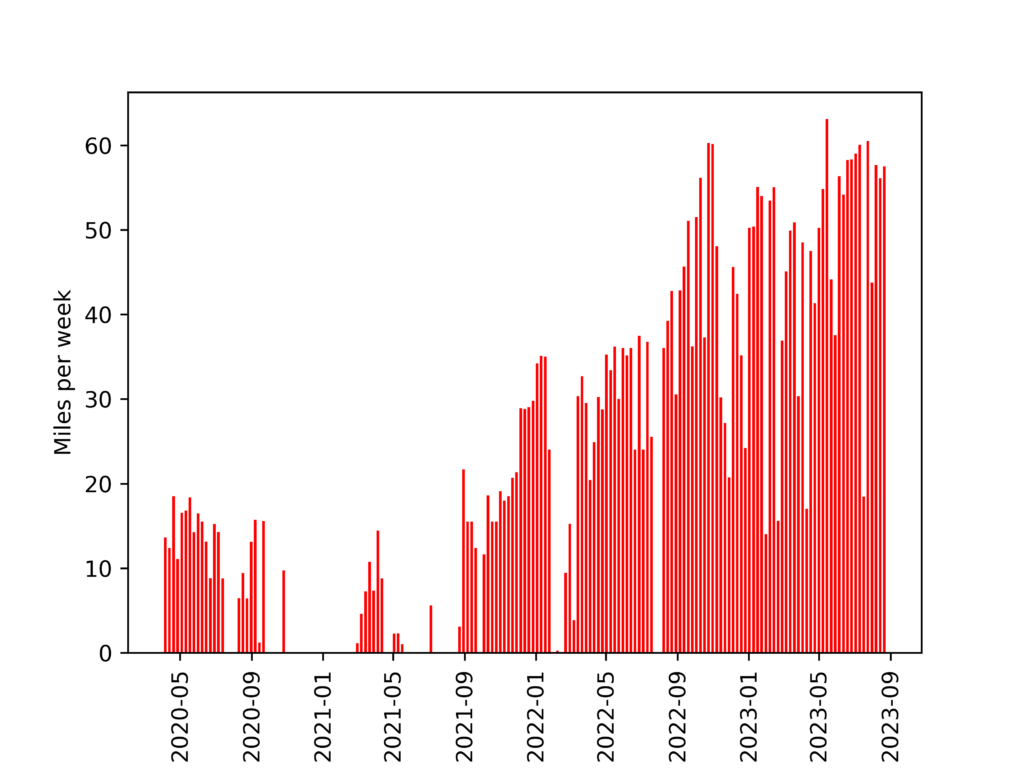
At first glance, this chart might suggest a struggle with running consistency until about two years ago. But the full picture requires a broader lens.
Total training time: including cycling and walking
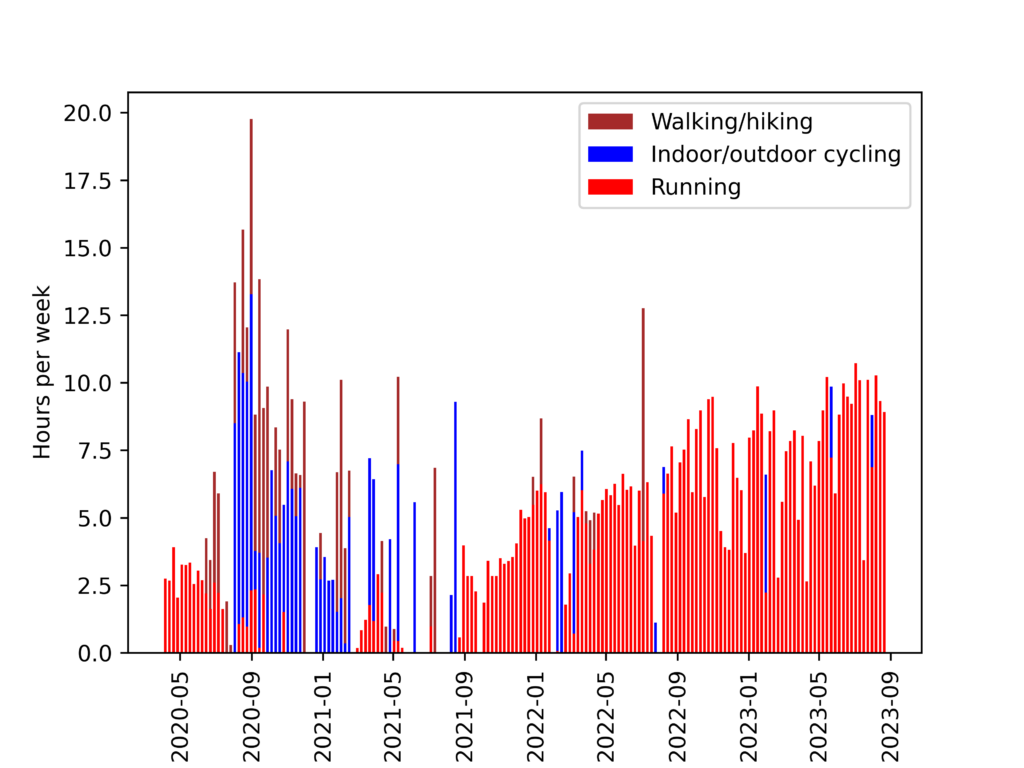
When you factor in cycling and walking/hiking activities from late 2020 to early 2021, it’s clear that this cross-training laid a crucial foundation for my subsequent focus on running. Although I wasn’t training “smartly” during that period, this trial-and-error phase was invaluable.
Length of the weekly long run
Finally, let’s look at my weekly long run. It’s the most important session if you train for a half-marathon or a longer distance. But what’s more crucial, it’s an opportunity to spend a few hours immersed in nature, which serves as one of my main motivators for training.
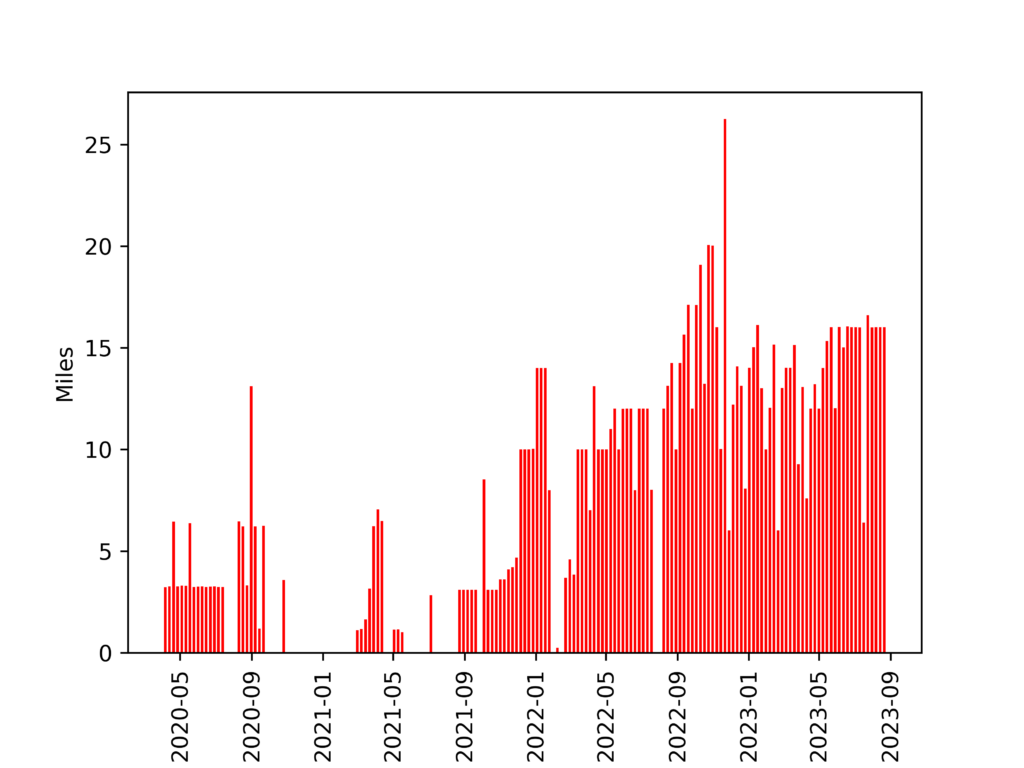
Year over year
To further underscore my growth as a runner, let’s compare the training volumes between my first and second years:
When we put the two years side by side, a significant “rightward shift” in the distributions becomes apparent. What this means more quantitatively is that I’ve become capable of managing a 50-60 mile week, featuring a 16-mile long run and a workout, with relative ease. Not so long ago, attempting such a regimen would have been a recipe for burnout or injury. In total, I clocked 1,206 miles in 211 hours during the first year of training, and 2,340 miles in 381 hours during the second year.
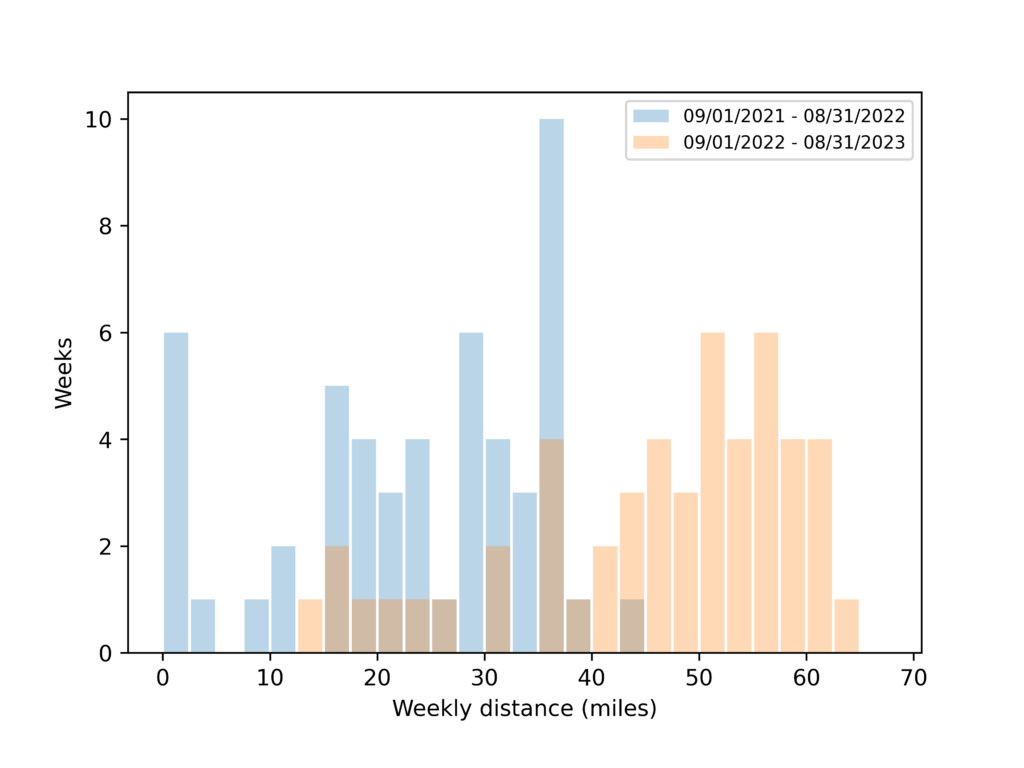
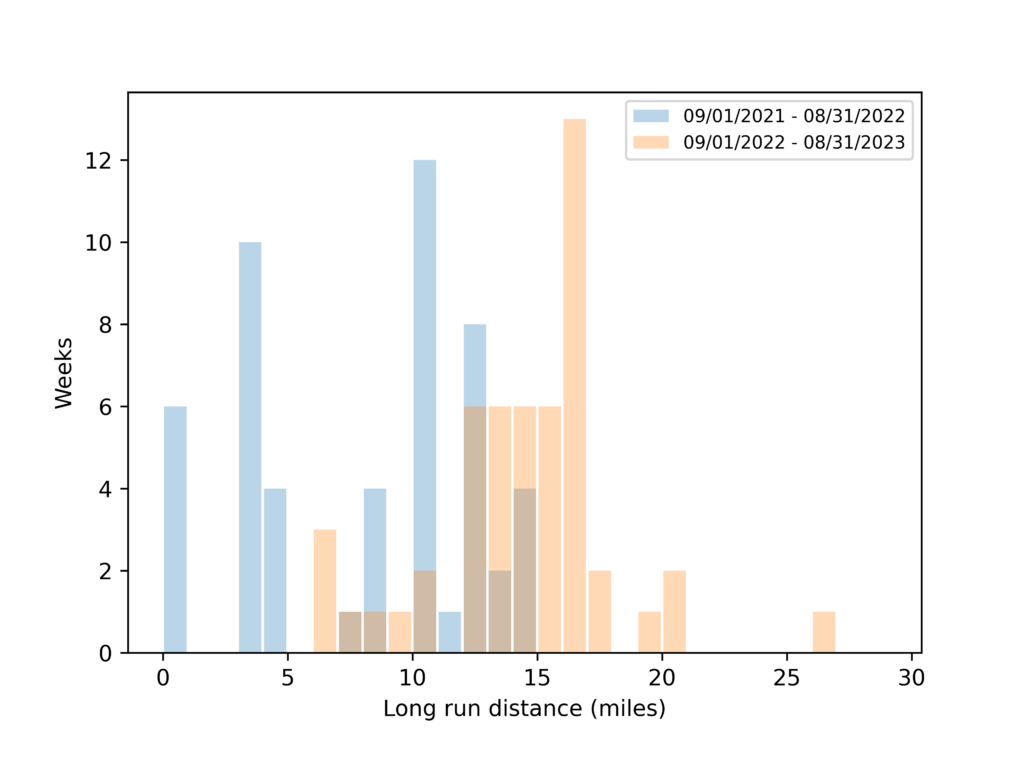
Wrapping up
The past two years have been a mix of miles, data, and learning experiences. While I’ve focused a lot on the numbers in this post, the real value has been in the day-to-day enjoyment of running and the physical and mental benefits it’s brought to my life.
Thanks for reading about my journey so far. Whether you’re an experienced runner or just considering getting started, I hope you find something useful in my story. Cheers to more running and more learning in the days ahead!